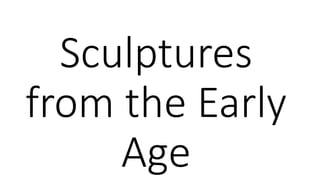Sculptures from the early age
•Descargar como PPTX, PDF•
5 recomendaciones•10,804 vistas
Denunciar
Compartir
Denunciar
Compartir

Recomendados
Sculptures from the Early Age
Sculptures from the Classical Period
Sculptures from the Medieval PeriodMAPEH Grade 9 - Arts - Sculptures from the Early Age, Classical Period, and M...

MAPEH Grade 9 - Arts - Sculptures from the Early Age, Classical Period, and M...Talangan Integrated National High School
Architecture from the Early Age
Architecture from the Classical Period
Architecture from the Medieval PeriodMAPEH Grade 9 - Arts - Architecture from the Early Age, Classical Period and ...

MAPEH Grade 9 - Arts - Architecture from the Early Age, Classical Period and ...Talangan Integrated National High School
Paintings from Ancient Egypt
Paintings from Classical Greek Era
Paintings from the Roman Era
Byzantine Paintings
Romanesque Paintings
Paintings from the Gothic EraMAPEH Grade 9 - Arts - Western Classical Art Traditions - Paintings - First Q...

MAPEH Grade 9 - Arts - Western Classical Art Traditions - Paintings - First Q...Talangan Integrated National High School
Recomendados
Sculptures from the Early Age
Sculptures from the Classical Period
Sculptures from the Medieval PeriodMAPEH Grade 9 - Arts - Sculptures from the Early Age, Classical Period, and M...

MAPEH Grade 9 - Arts - Sculptures from the Early Age, Classical Period, and M...Talangan Integrated National High School
Architecture from the Early Age
Architecture from the Classical Period
Architecture from the Medieval PeriodMAPEH Grade 9 - Arts - Architecture from the Early Age, Classical Period and ...

MAPEH Grade 9 - Arts - Architecture from the Early Age, Classical Period and ...Talangan Integrated National High School
Paintings from Ancient Egypt
Paintings from Classical Greek Era
Paintings from the Roman Era
Byzantine Paintings
Romanesque Paintings
Paintings from the Gothic EraMAPEH Grade 9 - Arts - Western Classical Art Traditions - Paintings - First Q...

MAPEH Grade 9 - Arts - Western Classical Art Traditions - Paintings - First Q...Talangan Integrated National High School
Más contenido relacionado
La actualidad más candente
La actualidad más candente (20)
Arts 9-1st Quarter DLP 1 Western Classical Art Traditions

Arts 9-1st Quarter DLP 1 Western Classical Art Traditions
Arts of the Renaissance and Baroque Period MAPEH 9

Arts of the Renaissance and Baroque Period MAPEH 9
Arts of the Romantic Period 1800-1810) (Goya, Delacroix, Gericault) For Grade...

Arts of the Romantic Period 1800-1810) (Goya, Delacroix, Gericault) For Grade...
Jonathan Carlos Lubag Arts 9 of the Neoclassic and Romantic Period.pptx

Jonathan Carlos Lubag Arts 9 of the Neoclassic and Romantic Period.pptx
Destacado
Destacado (12)
Similar a Sculptures from the early age
Similar a Sculptures from the early age (20)
grade9-arts-sculptures-firstquarter-190812154558.pptx

grade9-arts-sculptures-firstquarter-190812154558.pptx
grade9-arts-sculptures-firstquarter-190812154558.pptx

grade9-arts-sculptures-firstquarter-190812154558.pptx
westernclassicalarttraditionsgrade9-190927020125 (1).pdf

westernclassicalarttraditionsgrade9-190927020125 (1).pdf
INTRODUCING THE WESTERN AND CLASSICAL ART TRADITIONS Grade-9-LLM-2-ARTS.ppt

INTRODUCING THE WESTERN AND CLASSICAL ART TRADITIONS Grade-9-LLM-2-ARTS.ppt
The Philosophical Demotion of the Sacred Feminine Form in Classical Art 

The Philosophical Demotion of the Sacred Feminine Form in Classical Art
Más de Marivic35
Más de Marivic35 (7)
Sculptures from the early age
- 1. Sculptures from the Early Age
- 2. Pre-Historic sculptures- Materials used in sculptures vary according to region and locality. Archologists believed that their sculpture is a result of natural erosion and not of human artistry.
- 3. Venus of Willendorf- 28000BCE-25000 BCE -Image from treasures of the World, 1961 CCP Library. - it is carved from limestone with axcessively heavy breast and abdomen used as charm to ensure fertility.
- 4. Venus of brassempouy- from treasures of the World, 1961 CCP Library. - a sculpture of a lady with the hood. It is a fragmentary ivory figurine from the upper paleolithic era that realistically represents the human face and hairstyle.
- 5. Sculptures from the EGYPTIAN ERA
- 6. The most common materials used for sculptures are wood, ivory and stones.
- 7. Characteristics of the sculptures: 1. symbolisms were heavily used to represent the gods. They were represented as composite creature with animal heads on human bodies. 2. relief compositions were arranged in horizontal lines to record an event or represent an action.
- 8. 3. most of the time the gods were shown larger than humans, the kings larger than their followers, the dead larger than living. 4. empty space were filled with fingers of hieroglyphics 5. all individual components were all brought to the plane of representation and laid out like writing.
- 9. Queen Nefertiti, painted limestone-realistic with heavy lided eyes, slender neck, determined chin and pure profile under her heavy crown. -Queen, refers to the Great Royal wife of the Egyptian pharaoh.
- 10. The PharoahMenkaure and his Queen, stone- an example of protraits presented in rigid postures, and were simple and powerful with very little show of private emotion.
- 11. Sculptures from the Classical Period
- 12. Greek Sculptures- early Greek sculptures were tense and stiff, their bodies were hidden within enfolding robes. After three centuries of experiments, Greek sculptures had finally evolved and showed all the points of human anatomy and proportion. One of the most popular styles of the greek sculptures was the Hellenistic style. Hellenistic denotes a preference in sculpture for more elaborated patterns, mannered arrangement of figures and groups, and an emphasis on the representation of movement for dramatic effects.
- 13. Myron; The Discobulus-shows an attitude of maximum tension, full of compressed energy, and about to explode an action.